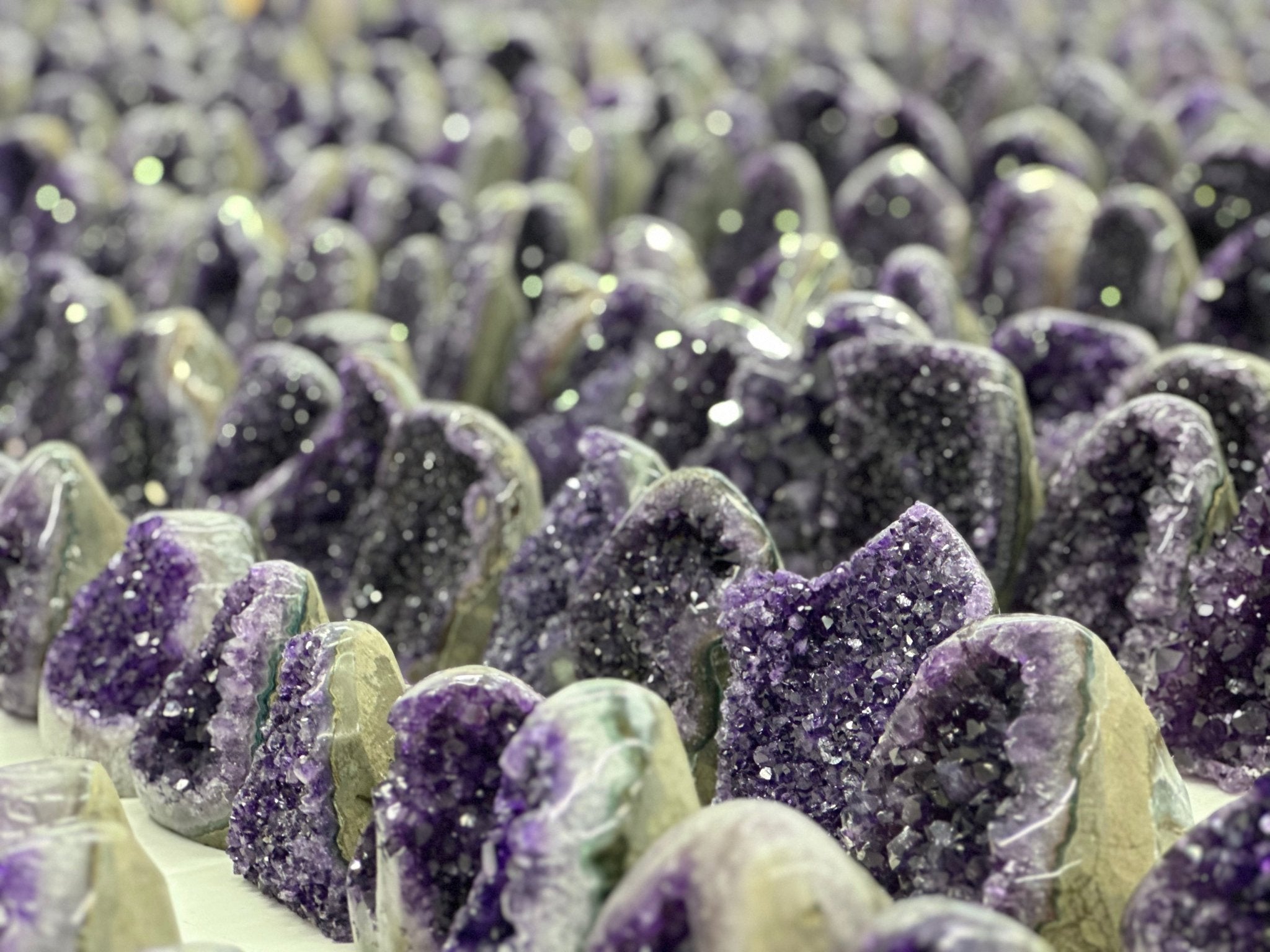Amethyst, with its mesmerizing purple hues and spiritual allure, has a fascinating origin rooted in geological processes that span millions of years. Let's look deeply into the fascinating journey of how amethyst is formed in nature, highlighting the conditions and transformations that give rise to this cherished gemstone.
How Is Amethyst Formed? The Role of Quartz
Amethyst is a variety of quartz, which is one of the most abundant minerals on Earth's crust. Quartz itself is composed of silicon and oxygen atoms arranged in a repeating pattern, making it a primary element of many rock formations. Amethyst’s distinctive purple coloration is courtesy of the presence of trace amounts of iron impurities within the quartz crystals.
Geological Formation: From Magma to Crystals
The formation of amethyst starts deep within the Earth's crust during volcanic or hydrothermal activities. When magma (molten rock) cools and solidifies underground, it frequently contains pockets of hot fluids rich in dissolved minerals. These mineral-rich fluids get into existing rock formations, leaving quartz crystals along with other minerals like iron.
Geological Timeframe: Millions of Years in the Making
The formation of amethyst is a testimony to the colossal timescales involved in geological processes. From the initial deposition of quartz-rich fluids to the slow growth and development of crystal formations, the journey of amethyst entails millions of years. Each amethyst crystal preserves a unique record of Earth's ancient history, capturing the incredible processes that shape our planet's geological history.
Geological Distribution of Amethyst
Amethyst deposits are found in geological settings all over the world, ranging from volcanic regions to sedimentary formations. Brazil is a well-known source of high-quality amethyst, particularly in the state of Rio Grande do Sul.
Other locations worthy of mention include Uruguay, Zambia, and Madagascar, each known for producing unique varieties of amethyst with distinct color characteristics and crystal formations. The geological distribution of amethyst shows the diverse conditions under which these crystals form, highlighting the geological diversity of our planet.
The Role of Hydrothermal Processes
Hydrothermal processes play a big part in the formation of amethyst. Hot water solutions containing silica (SiO2) and other minerals flow through cracks and cavities within existing rocks. When these solutions cool and interact with surrounding rocks, they deposit quartz crystals, including amethyst, within the cavities.
Coloration of Amethyst: The Influence of Iron
The purple color of amethyst is thanks to the presence of iron impurities within the quartz crystals. Specifically, iron atoms trapped in the crystal lattice of quartz absorb certain wavelengths of light, giving amethyst its characteristic violet to purple hues. The intensity and saturation of the color can be different depending on the concentration of iron and other impurities present during the crystal's formation.
Structural Variations: Clusters, Geodes, and Slices
Amethyst crystals can form in a number of structures, ranging from individual prismatic crystals to massive amethyst clusters and geodes. When conditions are right, quartz crystals grow slowly over time, allowing them to develop into intricate formations.
Amethyst geodes, in particular, are large hollow rocks lined with amethyst crystals, frequently displaying stunning arrays of deep purple hues. Amethyst slices, cut from larger geodes or clusters, show the internal beauty and unique patterns of these formations.
Growth Conditions and Environmental Factors
The growth of amethyst crystals is influenced by a number of environmental factors, including temperature, pressure, and the presence of specific mineral solutions. Slow cooling and stable conditions allow quartz crystals, including amethyst, to form gradually and develop their characteristic shapes and colors. Changes in these conditions over time can result in variations in crystal size, clarity, and coloration.
Mining and Discovery of Amethyst Deposits
Amethyst deposits are found in numerous regions around the world, including Brazil, Uruguay, Zambia, and Russia, among others. Mining operations often uncover amethyst crystals embedded within host rocks or extracted from underground veins and cavities. The discovery of amethyst deposits requires careful exploration and extraction techniques to preserve the integrity of the crystals and minimize environmental impact.
Mining operations for amethyst involve various techniques to extract crystals from underground deposits. Miners use tools like drills, explosives, and excavation machinery to access amethyst-bearing rocks and veins.
Careful extraction methods are needed to preserve the integrity of the crystals and minimize damage during the mining process. Once extracted, amethyst crystals go through sorting, cleaning, and processing before being prepared for sale or further refinement.
Crystal Growth and Formation
Amethyst crystals grow through a process called crystallization, where dissolved minerals in water solutions solidify over time to form crystal structures.
In the case of amethyst, silica-rich solutions containing trace amounts of iron flow into cavities and fractures within rocks. As these solutions cool and evaporate, quartz crystals begin to form. The presence of iron impurities within the quartz lattice gives rise to the characteristic purple color of amethyst.
Environmental Influences on Amethyst Color
The coloration of amethyst can be influenced by environmental factors during its formation. For example, exposure to natural radiation over long periods can affect the color intensity of amethyst crystals.
On the other hand, changes in temperature and pressure can affect crystal growth, causing differences in color and clarity. Amethysts found in different geological settings may exhibit unique color variations courtesy of these environmental influences.
Cultural Significance and Symbolism
Throughout history, amethyst has held cultural meaning and spiritual symbolism in certain civilizations. Ancient Greeks and Romans believed amethyst had protective properties and used it to adorn jewelry and amulets.
In medieval Europe, amethyst was associated with religious symbolism and considered a stone of sobriety and clarity.
Today, amethyst continues to be valued for its metaphysical properties, representing peace, healing, and spiritual awakening in contemporary crystal healing practices and holistic therapies.
Preservation and Appreciation of Amethyst
The formation of amethyst is testimony to the Earth's geological progressions and the transformative power of nature over vast periods of time. From volcanic activity to hydrothermal processes, amethyst crystals show the complex interactions that shape our planet's mineral wealth.
By preserving and appreciating these natural wonders, we are allowed insight into Earth's ancient history and can connect with the lasting beauty of the natural world. Amethyst's appeal continues to fascinate and inspire, inviting us to explore the mysteries of its formation and enjoy its timeless elegance.
Unveiling the Mysteries: An In-Depth Look at Amethysts
Amethysts have captivated collectors and admirers for centuries, their rich purple hues conjuring a sense of royalty and mystique. At Brazil Gems, we are passionate about sharing our extensive knowledge of these extraordinary gemstones, inviting you to look deeper into the world of amethysts and uncover their hidden secrets.
Brazil Gems takes pride in sourcing our amethysts from the finest regions of Brazil, known for producing some of the world's most exceptional specimens. Our collection showcases a vast array of amethyst varieties, from the classic deep purple to the rare and coveted green amethyst, a true marvel of nature.
Lose yourself in the captivating world of amethysts and uncover the hidden depths of these remarkable gemstones. Call 951-215-6455 today or email us at info@brazilgems.com to begin your journey of discovery with our knowledgeable experts.
